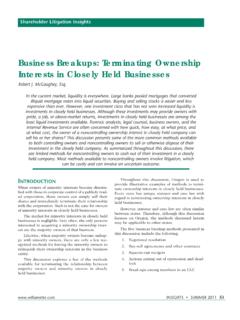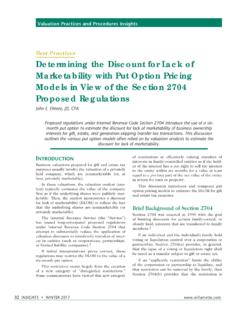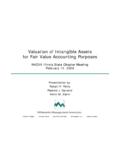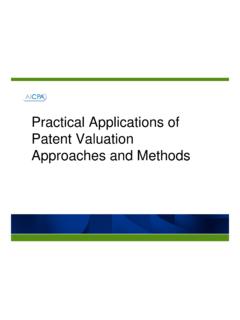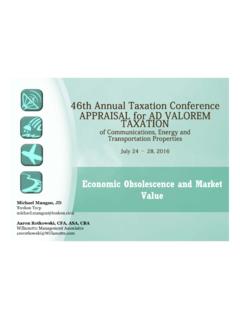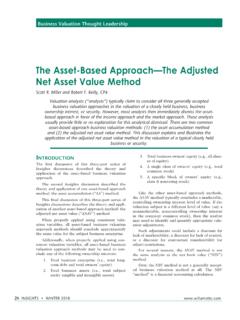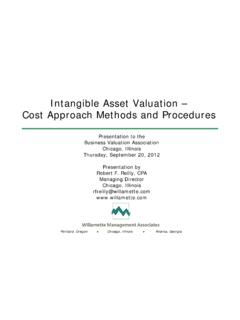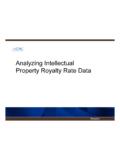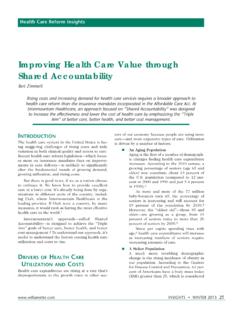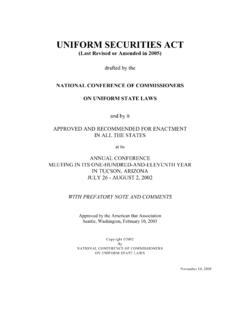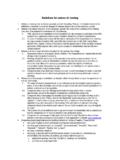Transcription of Dissenting Shareholder Appraisal Rights and …
1 8 INSIGHTS AUTUMN 2015 www .willamette .comintroDuctionLitigation involving Dissenting Shareholder Appraisal Rights claims and Shareholder oppression claims was relatively infrequent until the 1983 Weinberger v. UOP decision in the State of that judicial decision was handed down, the volume of litigation has increased significantly with respect to both Shareholder Appraisal Rights claims and Shareholder oppression better provide forensic valuation services, the valuation analyst should understand the evolution of Dissenting Shareholder Appraisal Rights and share-holder oppression understanding may help the valuation ana-lyst discern the economic elements that impact the valuation of a company in a Dissenting Shareholder Appraisal Rights case or in a Shareholder oppression addition, the valuation analyst should seek and rely on specific instruction from legal coun-sel.
2 Legal counsel should instruct the valuation analyst with regard to any of the legal differences between Dissenting Shareholder claims and share-holder oppression Shareholder Appraisal Rights actionsA Dissenting Shareholder who is exercising a statu-tory or contractual right to dissent from a corporate action may have the legal right to seek an Appraisal of his/her shares in the company. Dissenting share-holders typically have statutory Appraisal Rights in circumstances such as a merger, the sale of substan-tially all of the corporate assets, recapitalization, amendments to articles of incorporation that cre-ates fractional shares, or other major changes to the nature of their investment in the a statutory Dissenting Shareholder Appraisal Rights action, the exclusive Shareholder remedy is Shareholder Appraisal Rights and Shareholder Oppression Claims: Similarities and Differences in Securities ValuationLisa H.
3 Tran and Irina V. VrublevskayaShareholder Dispute Litigation InsightsOver the past three decades, the number of both Dissenting Shareholder Appraisal Rights claims and Shareholder oppression claims increased significantly. This increase has created a demand for forensic-related business and security valuation services. Valuation analysts are not legal counsel, of course. However, valuation analysts who practice in this area should be generally familiar with both the economic and the legal differences between Dissenting Shareholder Appraisal Rights issues and Shareholder oppression issues. While taking specific legal instruction from legal counsel, valuation analysts should have a general familiarity with the professional guidance provided by the American Bar Association, the American Law Institute, state statutes, and relevant judicial precedent in order to perform forensic-related valuation.
4 Willamette .com INSIGHTS AUTUMN 2015 9 History and OverviewAccording to the common law of most states in the early 19th century, the implementation of any extraordinary corporate decision required the unanimous vote of the corporation shareholders . Accordingly, a noncontrolling Shareholder could use this law to paralyze the decision-making process of the subject onset of the industrial revolution and the development of the transcontinental railroads con-vinced both the courts and the corporations that the unanimity vote requirement was an inefficient process to support the rapid growth in the increas-ingly complex 1892, the Illinois Supreme Court ruled in Wheeler v. Pullman Iron & Steel that corpo-rate policy should be decided by the majority of the shareholders . That is, corporate policy should not require the unanimous vote of all shareholders .
5 After the Wheeler decision, more courts began to adopt this so-called majority a result of the shift to the so-called majority rule, noncontrolling shareholders who disagreed with the decisions of the controlling shareholders were powerless to challenge such actions. However, such Dissenting shareholders could not exit the corporation if the shares were not publicly traded. This situation led to the development of statutory Appraisal Rights for such Dissenting noncontrolling the development of the Shareholder Appraisal Rights statutes, Dissenting noncontrol-ling shareholders had to petition the courts to stop a corporation from pursing a course of action until the noncon-trolling shareholders received the fair value (in cash) of their shares. These injunctive proce-dures were expensive, lengthy, and disruptive to the corporate busi-ness.
6 As a result, state legislatures implement-ed Shareholder Rights Appraisal statutes that allowed noncontrolling shareholders to dissent from specified corpo-rate 1927, the Uniform Business Corporation Act ( the Act ) was introduced by the National Conference of the Commissioners for Uniform State Laws. The Act was introduced to provide legislation that would bring clarity and uniformity to certain areas of the Act was adopted by only Louisiana, Washington, and Kentucky. This was because most states wanted the flexibility to make their own inter-pretation of the , during the first half of the 20th cen-tury, nearly all states adopted some form of a share-holder Appraisal Rights statute. Table 1 indicates the year when each state first adopted a Dissenting Shareholder Appraisal Rights , the majority of Dissenting Shareholder Appraisal Rights cases are a result of a controlling Shareholder squeezing out a noncontrolling share-holder for cash.
7 Although the specific procedures may vary from state to state, the events that result in a Dissenting Shareholder Rights action follow a specific , a corporation s board of directors is required to give notice of a contemplated corporate action from which noncontrolling shareholders may dissent. Any dissenters then decline the consid-eration and demand payment for their shares in a notice to the board of directors before the corporate action is demand initiates the Appraisal Rights case in which the dissenters lose all Rights to the corpora-tion, except the right to receive payment for the fair value of their corporate York 1890 Ohio 1906 Louisiana 1928 Maine 1891 Tennessee 1907 Idaho 1929 Kentucky 1893 Maryland 1908 Indiana 1929 New Jersey 1896 Vermont 1915 California 1931 Delaware 1899 Illinois 1919 District of Columbia 1931 Connecticut 1901 New Hampshire 1919 Michigan 1931 Pennsylvania 1901 Rhode Island 1920 Washington 1933 Alabama 1903 Arkansas 1925 Hawaii 1937 Massachusetts 1903 Florida 1925 Georgia 1938 Nevada 1903 North Carolina 1925 Arizona 1939 Virginia 1903 South Carolina 1925 Kansas 1939 Montana 1905 Minnesota 1927 New Mexico 1905 Oregon 1927 Table 1 Date When Each State First Passed a Dissenting Shareholder Appraisal Rights Statute10 INSIGHTS AUTUMN 2015 www.
8 Willamette .comshareholDer oppression actionsShareholder oppression actions typically are a result of closely held corporation shareholders (1) who claim to have been treated unfairly or prejudi-cially by the controlling Shareholder (s) and (2) who seek dissolution of the corporation or a buyout of their allegedly oppressed shareholders have to prove that the controlling Shareholder (s) purposely excluded them from their proper share of the ben-efits of corporate and OverviewThe need for a legal resolution to Shareholder oppression claims evolved in the same manner as the evolution of a remedy for Dissenting Shareholder Appraisal Rights claims. That is, both remedies resulted from the move to majority rule, which potentially could harm or ignore the interests of the noncontrolling Appraisal Rights actions, Shareholder oppres-sion actions are primarily based on state statutes.
9 For example, Illinois was the first state to recognize oppression as a trigger for the dissolution of a cor-poration in the 1933 Illinois Business Corporation Act. In 1953, the American Bar Association (ABA) incorporated the Illinois law into the Model Business Corporation Act s dissolution Shareholder oppression claims became more widely recognized, the courts had to define share-holder oppression and had to determine if such oppression had actually 1957, an Illinois court defined Shareholder oppression in Central Standard Life Insurance3 to include conduct by the majority that breaches fidu-ciary duty, denies the minority Shareholder his or her reasonable expectations in acquiring shares and entering into a Shareholder agreement, or is burden-some, harsh, and wrongful to minority Shareholder interests.
10 4 Shareholder oppression claims are dif-ferent from Shareholder Appraisal Rights claims in several respects. For example, Shareholder oppres-sion is generally more personal, and Dissenting Shareholder Appraisal Rights claims are the result of a financial decision by a oppression often involves the loss of employment, the exclusion of a Shareholder who founded and assisted in the growth of the corpora-tion, or a significant disagreement between close corporation family owners or business similarity between Dissenting Shareholder Rights claims and Shareholder oppression claims is the application of the fair value standard of value by most states. Many courts agree that fair value has the same meaning in the context of Shareholder oppression claims and in the context of Dissenting Shareholder Rights claims.
